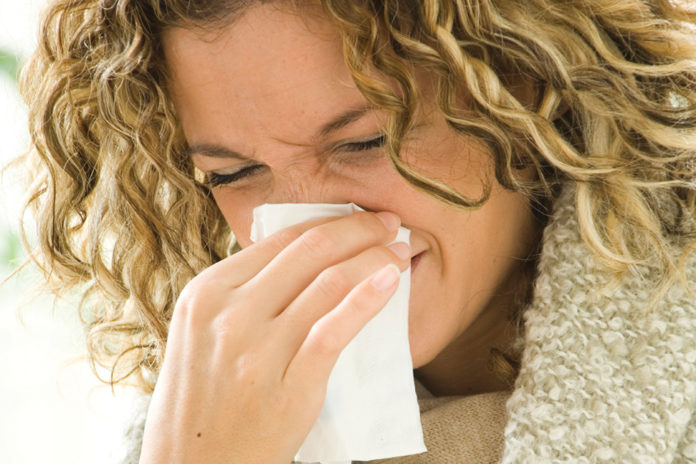
Staying germ-free and cold-free this season
by paul aguirre
Your mama was right about germs, wearing your gloves and scarf — and oh yeah, all those other things that come with the cold and flu season. Truth is, most of us get the sniffles not from whom we touch, but what and where we touch, so it’s time to see what’s really on the surface. In all seriousness, autumn is the best time to be proactive about planning a family prevention strategy for influenza. This year in particular is expected to be quite a challenge to our immune system due to the H1N1 virus also known as swine flu. Although a vaccine is in the works, health specialists tell us that everyone plays an important role in preventing the spread of these viruses and germs. That’s why continued yearlong and seasonal healthy habits from the get-go are key for preventing and treating such infections. Here are some considerations when it comes to steering clear of the cold and flu, and some simple solutions to combat the “ick” factor.
NUTRIENTS AND IMMUNE FUNCTION
Several immune responses, including antibody production, lymphocyte proliferation, cytokine production and white blood cells are influenced by nutrient intakes. These are the warriors on the first line, of defense and subsequent fallbacks, of infection. According to the American Journal of Clinical Nutrition, the immune response of those with poor diets or genetic predisposition, or certain populations like infants and the elderly, can be increased through supplementation.
Your immune system really is the key to making you feel and look good. In addition to supplementation and eating properly, consider monitoring alcoholic beverages that can weaken immune responses and try to maintain a healthy body weight. There’s also that pesky thing known as stress, which is a strong depressant of immune function. Try stress-reducing techniques as a little something extra (think of it as “healthy sugar on top”) to stimulate immune function such as relaxation exercises, meditation and biofeedback.
WHERE YOU LEAST EXPECT IT
Think about these interesting places where germs live:
Your Office Phone. Office essentials such as chairs, keyboards and mice are notorious germ hideouts. Your phone is the frontrunner. With more than 25,000 germs per square inch, it needs a good wipe every now and then — especially if you change desks or start a new gig.
The Kitchen Sink. Think twice before washing those veggies. With the dishes piling up and all the rinsing of other very dirty things, it’s no surprise the average kitchen drain has thousands of bacteria per square inch — more than most bathrooms.
Your Handbag. Your favourite handbag (the one you never let go of) might just be your biggest germ risk. Most people “clean” a handbag by moving the essentials from one bag to another and tossing old receipts, but the bottom of that bag houses thousands of bacteria — perhaps tens of thousands. Your husband’s briefcase or child’s backpack can’t be too far behind.
IMMUNE BOOSTING PLAN
Vitamin C | A wonder when it comes to keeping that pesky cold at bay, several trials with military personnel and other participants under comparable conditions found that vitamin C substantially reduced the incidence or severity of respiratory infections. Vitamin C
acts as an immuno-stimulant by promoting white blood cell production and antibody responses, as well as plays a part in the secretion of thymic hormones that stimulate immune cell production and keep you in top form.
Garlic | Garlic is a known superfood for its ability to kill flu and cold viruses. When finely chopped, garlic produces a powerful antibacterial known as allicin; according to research from The Garlic Information Centre in the UK, allicin can help reduce the risk of catching a cold by approximately
50 percent.
Goldenseal | An herbal wonder with very traditional roots, it helps by restoring a healthy flow of mucous to stagnant membranes. Goldenseal also contains astringent factors, and by increasing the healthy mucous, which has its own antibodies, it may be effective a few days into the sniffles when sinuses are all stuffy.
Echinacea | Echinacea contains polysaccharides, flavonoids, essential oils, polyacetylenes and alkylamides that act as immune system stimulators, giving the herb antiviral and antibacterial properties. It’s also been noted that it has the ability to boost white blood cell movement into infected areas of the body.
Zinc | A study from Wayne State University has noted that zinc may be essential for everything from growth to brain functioning, linking this to immune system-related disorders as well as increased susceptibility to infectious diseases. Researchers toot its antioxidant ability and anti-inflammatory properties, since zinc lozenges have become a staple for cold and flu sufferers.
Oil of Oregano | Used by the ancient Greeks, this marvel extracted from wild oregano plants contains key compounds carvacrol and thymol. Some people often confuse this with its cooking agent, so it’s important to verify that the oil comes from the proper plant and has at least a 70 percent carvacrol concentration. For cold and flu sufferers, a standard recommendation is three drops once per day (mix it with your OJ!) and works best as an early defense before those symptoms kick in full-force.
REFERENCES
Bergner, Paul. “Goldenseal and the Antibiotic Myth.” Medical Herbalism: A Journal for the Clinical Practitioner. Volume 8, Number 4; Winter 1996-1997.
Douglas RM, et al. “Vitamin C for preventing and treating the common cold.” Cochrane Database Syst Rev. 2004 Oct 18.
Hemilä, Harri. “Vitamin C Supplementation and Respiratory Infections: A Systematic Review”. Military Medicine. 05 Jul, 2009.
Prasad AS. “Zinc in human health: Effect of zinc on immune cells.” Mol Med. 2008 May-Jun;14(5-6):353-7.
Woelkart K, et. “Echinacea for preventing and treating the common cold.” Planta Med. 2008 May;74(6):633-7.










